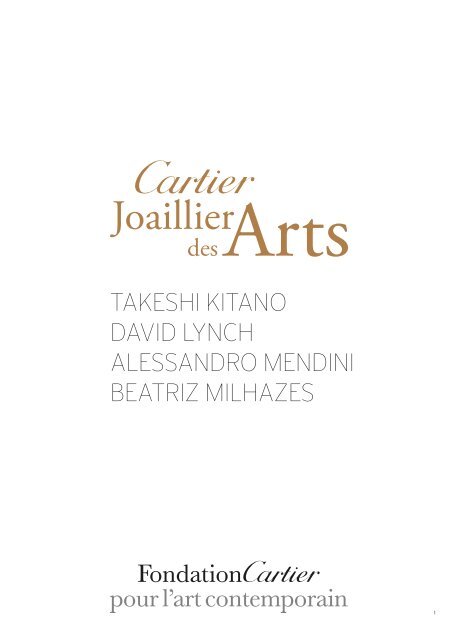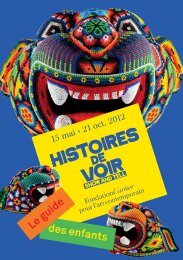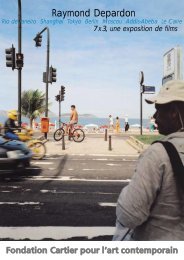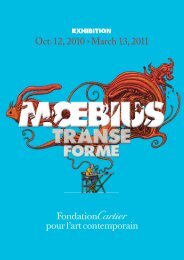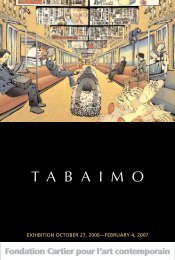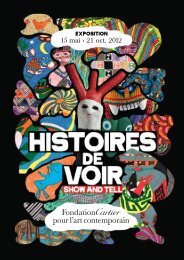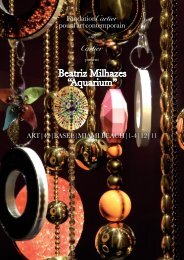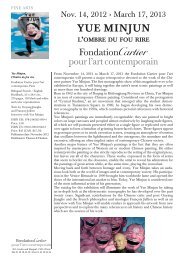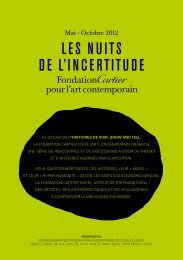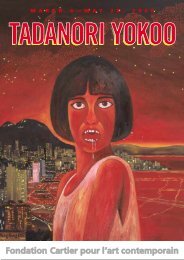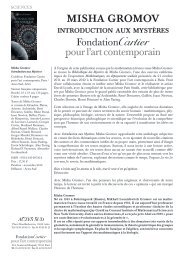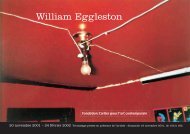Download - Fondation Cartier pour l'art contemporain - Cartier
Download - Fondation Cartier pour l'art contemporain - Cartier
Download - Fondation Cartier pour l'art contemporain - Cartier
You also want an ePaper? Increase the reach of your titles
YUMPU automatically turns print PDFs into web optimized ePapers that Google loves.
Takeshi kiTano<br />
DaviD Lynch<br />
aLessanDro MenDini<br />
BeaTriz MiLhazes<br />
1
The <strong>Fondation</strong> <strong>Cartier</strong> <strong>pour</strong> l’art <strong>contemporain</strong> and <strong>Cartier</strong><br />
present<br />
from April 3 – 21, 2012<br />
<strong>Cartier</strong> Jeweler of the Arts<br />
To create a work of art using precious or semi-precious stones that have been pierced,<br />
engraved, unmounted or even damaged, and can therefore no longer be used in classic<br />
jewelry; to bestow new life on these pearls, emeralds, sapphires, mandarin garnets,<br />
moonstones, paved diamonds, chalcedonies, rubies… This was the mission that the<br />
<strong>Fondation</strong> <strong>Cartier</strong> <strong>pour</strong> l’art <strong>contemporain</strong> and <strong>Cartier</strong> entrusted to four internationally<br />
renowned contemporary artists, well known to the <strong>Fondation</strong>.<br />
David Lynch, Alessandro Mendini, Takeshi Kitano and Beatriz Milhazes each met and<br />
worked with the <strong>Cartier</strong> master jewelers; from this passionate exchange four exceptional<br />
art works were created – extraordinary unique materials for the artists and a new life for<br />
these stones that no longer corresponded to the jeweler’s high standards.<br />
The development and execution of this veritable précis of gemology was the work of<br />
<strong>Cartier</strong> Joaillerie, while each artist and their creation revived the soul of these stones and<br />
symbolized their eternity in their own special way. Together, artists and master jewelers<br />
have crafted a precious story of gemstones.<br />
Bernard Fornas<br />
President & CEO <strong>Cartier</strong> International<br />
2
Nécessaire Gosse de peintre<br />
Takeshi Kitano<br />
The Nécessaire Gosse de peintre is a unique piece imagined by Japanese filmmaker Takeshi<br />
Kitano in 2010. Inspired by the Japanese artist’s funny, dreamlike world, this suitcase<br />
combines all the indispensable accessories a “perfect painter” could need. Made by the<br />
Ateliers <strong>Cartier</strong>, it bears witness to <strong>Cartier</strong>’s savoir-faire in crafting leather, gold, quartz and<br />
obsidian to make this offbeat creation.<br />
In his exhibition Beat Takeshi Kitano, Gosse de peintre, presented at the <strong>Fondation</strong> <strong>Cartier</strong><br />
in 2010, Takeshi Kitano made a subtle and mischievous foray into the world of childhood<br />
that was full of surprises, gags and games. The creation of the Nécessaire Gosse de peintre<br />
is a direct prolongation of the exhibition: from brushes to palette, cup to easel, beret to<br />
candies and pencils to an inflatable muse, the painter has everything necessary in this<br />
complete suitcase to create a masterpiece in any location.<br />
The Nécessaire Gosse de peintre was exhibited at Art Basel and Art Basel Miami in 2010.<br />
3
Nécessaire Gosse de peintre<br />
Takeshi Kitano<br />
4
Takeshi Kitano<br />
Born in 1947, Takeshi Kitano is a Japanese filmmaker who has directed major films such<br />
as Sonatine (1993), Hana-Bi (1997), Zatoichi (2003), Achilles and the Tortoise (2008)<br />
and Outrage (2010). Kitano is internationally famous for his films and hugely popular in<br />
Japan as a comedian and television presenter. His tireless curiosity and passion for learning<br />
and transmitting knowledge allow him to change fields and vocabulary with great ease,<br />
switching from violence to humor and excess to restraint.<br />
In 2010, he presented his first personal exhibition at the <strong>Fondation</strong> <strong>Cartier</strong> <strong>pour</strong> l’art<br />
<strong>contemporain</strong>, Beat Takeshi Kitano, Gosse de peintre. Through painting and videos,<br />
fantastical installations and incredible machines, Takeshi Kitano led the visitor from games<br />
to lessons, making fun of contemporary art, enjoying the sciences and playing on the<br />
clichés commonly associated with his native Japan.<br />
In 2011, he took part in the thematic exhibition Mathematics: A Beautiful Elsewhere at the<br />
<strong>Fondation</strong> <strong>Cartier</strong>, with the game The Answer is 2011.<br />
5
Jeweled Triangle<br />
David Lynch<br />
Continuing the fruitful relationship between David Lynch and the <strong>Fondation</strong> <strong>Cartier</strong> <strong>pour</strong><br />
l’art <strong>contemporain</strong>, <strong>Cartier</strong> gave the artist and director carte blanche to create a singular<br />
piece in 2009: Jeweled Triangle. Using precious and semi-precious stones, David Lynch<br />
reinvented an everyday object close to his heart: a lamp.<br />
When lit, this luminous work, a machine in motion, creates a decidedly “Lynchian”<br />
atmosphere. Combined with the rhythmical movement of the three colored gems<br />
– citrine, amethyst, green beryl – the light dancing over the smooth white metal shows the<br />
ease with which David Lynch plunges us into his mysterious, surrealistic and surprising<br />
world. In keeping with the intrinsically hypnotic power of gemstones, this lamp explores<br />
our relationship to light, reflections and the symbolism of stones, while questioning the<br />
way we relate to everyday objects.<br />
Jeweled Triangle was first shown at Art Basel Miami Beach in 2009 along with Alessandro<br />
Mendini’s <strong>Cartier</strong> Column. On <strong>Cartier</strong>’s initiative, David Lynch also directed a short film<br />
entitled Diamonds, Gold and Dreams for the occasion. This cosmic work – a veritable<br />
kaleidoscope of magnified diamonds – was projected directly on the <strong>Cartier</strong> Dome, which<br />
it transformed into an elaborate planetarium. For the <strong>Cartier</strong> joaillier des arts exhibition at<br />
the <strong>Fondation</strong> <strong>Cartier</strong>, the film will again be screened in a dome, allowing viewers to lose<br />
themselves in a world of infinite dreams.<br />
6
Jeweled Triangle<br />
David Lynch<br />
7
David Lynch<br />
Born in Montana, USA, in 1946, David Lynch spent his childhood painting and drawing.<br />
He directed his first experimental film in Philadelphia in 1965, at the Pennsylvania Fine<br />
Arts Academy. Since then, he has shot ten feature films, including Wild at Heart, which<br />
was awarded the Palme d’Or at the Cannes Film Festival in 1990. Acknowledged as one<br />
of the most original directors of his time, David Lynch is also a photographer, a musician<br />
and an artist, and was the youngest filmmaker to have won a Golden Lion for his oeuvre,<br />
at the 2006 Venice Film Festival. In 2007, David Lynch presented the exhibition The<br />
Air is on Fire at the <strong>Fondation</strong> <strong>Cartier</strong>, bringing together a large selection of works, some<br />
dating back to the 1960s: drawings, paintings, photos, experimental movies and sound<br />
environments were especially created for the exhibition. In 2011, he took part in the<br />
Mathematics: A Beautiful Elsewhere thematic exhibition at the <strong>Fondation</strong> <strong>Cartier</strong> by creating<br />
the design for the ground floor and a number of films commissioned for the event.<br />
8
The <strong>Cartier</strong> Column<br />
Alessandro Mendini<br />
The <strong>Cartier</strong> Column is a unique work imagined by the Italian architect and designer<br />
Alessandro Mendini. The artist wanted “to create an idealized symbol of utopian purity,<br />
one that would replace religious devotion and the ostentation of royal power with a nonreligious,<br />
abstract and spiritual treasure.”<br />
Thanks to an extraordinary set of precious and semi-precious stones that could no longer<br />
be of use to <strong>Cartier</strong>, Alessandro Mendini has created an exceptional “endless column”<br />
that produces a magical play on radiance and reflections. Following the principles of<br />
Greco-Roman architecture in a feat of ingenuity, the column is composed of seven blocks<br />
stacked around a central axis: after being selected, the stones were sorted into categories,<br />
encapsulated in crystal cylinders and inserted vertically inside pink gold fluting. Topazes,<br />
citrines, peridots, emeralds: all the stones in this lapidary collection were set in epoxy<br />
resin following 24 hours of polymerization. The <strong>Cartier</strong> Column stands 2.30 m high,<br />
weighs 400 kg and contains 24 kg of gold; it required over 18 months of work, from the<br />
preliminary sketches to the final creation.<br />
The <strong>Cartier</strong> Column was first presented at Art Basel Miami Beach in 2009 with the Jeweled<br />
Triangle lamp by David Lynch. It was subsequently shown at Art Dubai in 2011, along<br />
with the first showing of a series of eight drawings by Mœbius entitled Matter and Light.<br />
9
The <strong>Cartier</strong> Column<br />
Alessandro Mendini<br />
10
Alessandro Mendini<br />
Alessandro Mendini is a trained architect and designer who was born in Milan in 1931.<br />
A partner in the Nizzoli firm and co-founder of the Global Tools alternative movement,<br />
he was successively editor-in-chief of the magazines Casabella, Modo, and the architecture<br />
magazine Domus. In the late 1970s he joined the Studio Alchimia and developed his<br />
theories on kitsch and the banal object. His career then built up around collaborations<br />
with firms such as Alessi, Venini, Philips, Bisazza and Swatch. In 1989 he created the<br />
studio Atelier Mendini.<br />
He is purposefully polyvalent and associates his work with interior design, painting,<br />
music and literature. Alessandro Mendini’s pieces invent, duplicate, superimpose and defy<br />
definition. His objects never resemble their function, they instead take the form of the<br />
feeling they elicit from us, thus making his work firmly anti-conventional.<br />
In 2002, the <strong>Fondation</strong> <strong>Cartier</strong> presented Alessandro Mendini’s most emblematic works in<br />
the exhibition Fragilisme, alongside a series of commissions that included the monumental<br />
Poltrona di Proust – a famous Regency armchair whose pointillist design has reappeared on<br />
various objects since 1978 – and the Petite Cathédrale, entirely covered in mosaic.<br />
He is currently creating the design for a <strong>Fondation</strong> <strong>Cartier</strong> exhibition; presented from<br />
May 13 to September 30, 2012, this thematic exhibition unites a selection of works often<br />
associated with self-taught art or art brut.<br />
11
Aquarium<br />
Beatriz Milhazes<br />
In response to a commission from <strong>Cartier</strong>, Beatriz Milhazes imagined and designed an<br />
installation made up of suspended elements and decorative motifs. Composed of 15<br />
strands, the longest of which measures almost 2 metres, Aquarium is a richly decorated<br />
mobile in monumental dimensions, crafted in 2010 by the Ateliers <strong>Cartier</strong>.<br />
Inspired by the motifs and colours of her paintings and collages, the mobile was created<br />
with exquisite attention to detail. Choosing from a vast array of precious and semiprecious<br />
stones and pearls to adorn this work, Beatriz Milhazes took the same care as<br />
she does when choosing the colors in her painting palette: diamonds, rubies, opals,<br />
topazes, sapphires, turquoises… Rosettes, abstract and floral ornaments, geometric forms,<br />
rhythmic motifs and arabesques are associated with unexpected materials such as resin and<br />
metal to compose a fantastic, theatrical work that is both pure and surprising.<br />
Aquarium was exhibited at Art Basel and Art Basel Miami Beach in 2011. The work will<br />
also be presented at Art Dubai in March 2012.<br />
12
Aquarium<br />
Beatriz Milhazes<br />
13
Beatriz Milhazes<br />
Born in Rio de Janeiro in 1960, Beatriz Milhazes studied at the Curso de Comunicação<br />
Social (FACHA) and the Escola de Artes Visuais de Parque Lage in Brazil from 1978 to<br />
1982. Composed of a sumptuous superimposition of ornamental motifs, her dazzling,<br />
hypnotic paintings refer to Colonialist Baroque, Modernism and Brazilian popular art.<br />
Shown in numerous galleries and international biennials (Venice Biennale 2003), her work<br />
features in the collections of the world’s greatest museums, such as the Museo Reina Sofia in<br />
Madrid or the 21st Century Museum of Contemporary Art in Kanazawa; in New York, she<br />
is one of the rare artists of her generation to have major paintings in the collections of the<br />
Museum of Modern Art, the Guggenheim Museum and the Metropolitan Museum of Art.<br />
For her exhibition at the <strong>Fondation</strong> <strong>Cartier</strong> in 2009, Beatriz Milhazes presented a set<br />
of paintings selected among works from the past ten years, plus a monumental collage<br />
created especially for the event. In 2011, she created the O Paraiso collage for the<br />
exhibition Mathematics: A Beautiful Elsewhere at the <strong>Fondation</strong> <strong>Cartier</strong>.<br />
14
Since moving to Paris in 1994, the <strong>Fondation</strong> <strong>Cartier</strong> has been housed in an airy building filled<br />
with light that was designed by the architect Jean Nouvel. In this unique setting, exhibitions,<br />
conferences and artistic productions come to life.<br />
At once a creative space for artists and a place where art and the general public can meet,<br />
the <strong>Fondation</strong> <strong>Cartier</strong> <strong>pour</strong> l’art <strong>contemporain</strong> is dedicated to promoting and raising public<br />
awareness of contemporary art. Each year, the <strong>Fondation</strong> <strong>Cartier</strong> organizes a program of<br />
exhibitions based on either individual artists or themes, and commissions work from artists,<br />
thus enriching an important collection. It also organizes the Nomadic Nights, a rendezvous that<br />
focuses on the performing arts, where artists explore links between the visual arts and other forms<br />
of contemporary artistic expression. Exhibitions and the collection itself are frequently sent to<br />
institutions abroad, enhancing the <strong>Fondation</strong> <strong>Cartier</strong>’s international profile.<br />
As a reflection of our times, the <strong>Fondation</strong> <strong>Cartier</strong> embraces all creative fields and genres of<br />
contemporary art, ranging from design to photography, from painting to video art and from<br />
fashion to performance art. This testifies to the <strong>Fondation</strong> <strong>Cartier</strong>’s commitment and skill, to its<br />
blend of rigor and eclecticism which opens up contemporary art and renders it more accessible.<br />
Recognized on the international artistic scene and hailed by the public, the <strong>Fondation</strong> <strong>Cartier</strong><br />
distinguishes itself by its curiosity, originality and heterogeneity.<br />
15
FroM ApriL 3 rD To ApriL 21 sT 2012<br />
prEss oFFiCEs<br />
<strong>Cartier</strong>:<br />
Patricia Schiffbauer +33 1 58 18 10 18<br />
patricia.schiffbauer@cartier.com<br />
<strong>Fondation</strong> <strong>Cartier</strong> <strong>pour</strong> l’art <strong>contemporain</strong>:<br />
Matthieu Simonnet +33 1 42 18 56 77<br />
matthieu.simonnet@fondation.cartier.com<br />
Visits and conferences on Wednesdays, Saturdays and Sundays.<br />
Reservation with the Visitor’s Department necessary.<br />
Information on www.fondation.cartier.com/cartier<br />
Telephone: +33 1 42 18 56 67<br />
16


